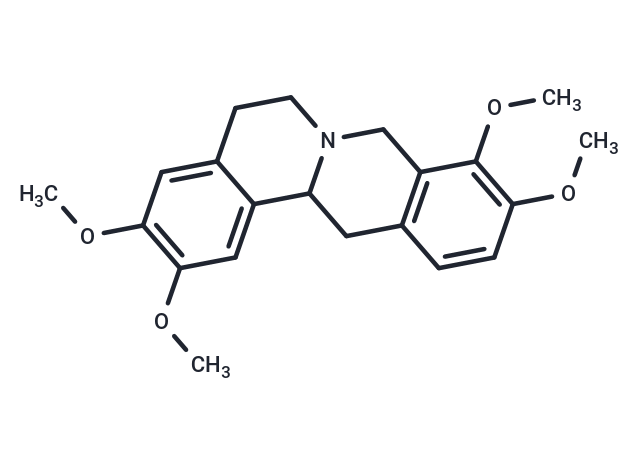Shopping Cart
- Remove All
 Your shopping cart is currently empty
Your shopping cart is currently empty

L-(R,S)-Tetrahydropalmatine (Rotundine) is extracted from Corydalis yanhusuo W. T. Wang.

| Pack Size | Price | Availability | Quantity |
|---|---|---|---|
| 50 mg | $29 | In Stock | |
| 100 mg | $42 | In Stock | |
| 200 mg | $58 | In Stock | |
| 500 mg | $98 | In Stock | |
| 1 g | $145 | In Stock | |
| 1 mL x 10 mM (in DMSO) | $29 | In Stock |
| Description | L-(R,S)-Tetrahydropalmatine (Rotundine) is extracted from Corydalis yanhusuo W. T. Wang. |
| In vitro | Rotundine displays a higher affinity to dopamine D1 than D2 receptor with Ki of 124 nM and 388 nM, respectively, while the IC50 values are 166 nM (D1) and 1.47 μM (D2), respectively. Rotundine exhibits a weak inhibitory activity against dopamine D3 with IC50 of 3.25 μM. Rotundine also potently inhibits 5-HT1A with IC50 of 374 nM and Ki of 340 nM. In addition to the antagonism of postsynaptic dopamine receptors, inhibition of presynaptic autoreceptors by Rotundine leads to increased dopamine release, which is probably attributed to lower affinity of Rotundine for D2 receptors. Along with dopamine receptors, Rotundine can interact with a number of other receptor types, including α-1 adrenergic receptors, at which it functions as an antagonist, and γ-aminobutyric acid receptors, at which it facilitates γ-aminobutyric acid binding through positive allosteric effects. [1] |
| Alias | TETRAHYDROPALMATINE HYDROCHLORIDE |
| Molecular Weight | 355.43 |
| Formula | C21H25NO4 |
| Cas No. | 10097-84-4 |
| Smiles | COC1=C(OC)C=C2C3CC4=C(CN3CCC2=C1)C(OC)=C(OC)C=C4 |
| Relative Density. | 1.23 g/cm3 |
| Storage | Powder: -20°C for 3 years | In solvent: -80°C for 1 year | Shipping with blue ice. | |||||||||||||||||||||||||||||||||||
| Solubility Information | Ethanol: < 1 mg/mL (insoluble or slightly soluble) DMSO: 55 mg/mL (154.74 mM), Sonication is recommended. H2O: < 1 mg/mL (insoluble or slightly soluble) | |||||||||||||||||||||||||||||||||||
Solution Preparation Table | ||||||||||||||||||||||||||||||||||||
DMSO
| ||||||||||||||||||||||||||||||||||||

Copyright © 2015-2025 TargetMol Chemicals Inc. All Rights Reserved.